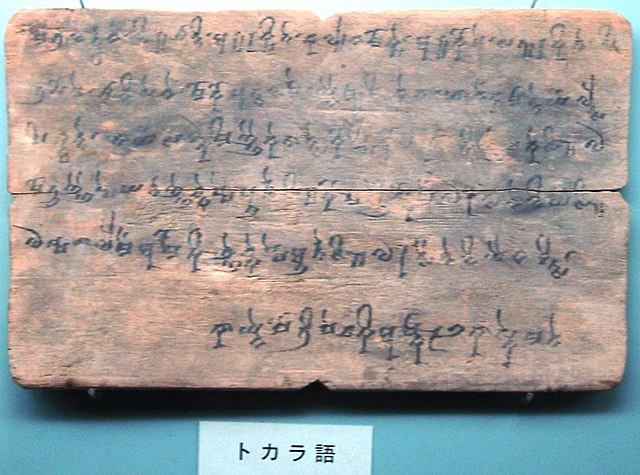热门问题
时间线
聊天
视角
吐火罗语
已滅絕語言 来自维基百科,自由的百科全书
Remove ads
吐火罗语(英语:Tocharian languages)是印欧语系最东方的一族颚音类语言,现已灭亡。

Remove ads
分类
吐火罗语族包含两种语言,
历史


- 1907年德国学者弗里德里希·威廉·卡尔·米勒在普鲁士科学院学报发表论文,米勒根据一篇回纥文佛经跋文中一段文字:“回纥文的《弥勒下生经》,先从印度语译为twγry语,又从twγry语译为突厥语”,认为twγry就是历史上的“Tokharoi”,因此将此种未为人知的语言定名为吐火罗语[3]。
- 德国哥廷根大学印度学教授埃米尔·西格和威廉·西格林教授研究格伦威德尔和冯·勒柯克从中国新疆吐鲁番带回柏林的婆罗米字母书写残卷,在1908年发表论文:《吐火罗语,月氏人之语言》[4]。作者认为吐火罗语,实为两种方言,定名为甲种吐火罗语、乙种吐火罗语,又因为吐火罗语中的一些词如 trai (三), oḵdh(八),mācaṟ(母亲)等和印欧语中同意词相似,定为吐火罗语为印欧语系。由于仅有甲种方言木简中存在回纥文佛经跋文中提及的《弥勒下生经》残卷,他们认为只有甲种方言才是twγry语,即吐火罗语。两位学者还首次提出吐火罗语就是月氏语。
Remove ads
法国语言学家西尔万·莱维研究1907年伯希和从新疆库车和敦煌带回巴黎的婆罗米文木简,在1913年发表论文《所谓乙种吐火罗语即龟咨语考》[5],断定库车的婆罗米木简属于乙种吐火罗语;由于乙种吐火罗语不仅用于库车佛寺而且用于官方通行证,莱维将“乙种吐火罗语”定名为龟兹语。莱维根据婆罗米木简有“大王Swarnate”字句,考订为《唐书》中于唐贞观四年来朝的龟兹王白苏伐叠,由此断定龟兹语木简的年代是唐贞观年间。莱维又根据中国最早的2世纪佛经译本中的佛教用语如“沙门”、“沙弥”不能对上梵文的sramana、sramenera,但与龟兹语的ṣamāne、ṣanmir很近,断定中国2世纪佛经必定是从原始的龟兹语翻译而来。
莱维将乙种吐火罗语考订为龟兹语根据有三:
- 乙种吐火罗语婆罗米木简出土自库车;
- 乙种吐火罗语用于库车佛寺和用于库车官方通行证;
- 乙种吐火罗语婆罗米木简有人名“Swarnate”,可考为龟兹王白苏伐叠。
莱维考证乙种吐火罗语为龟兹语,论据充份,已为学界普遍接受为定论。
Remove ads
- 伯希和认为所谓“甲种吐火罗语”和“乙种吐火罗语”都不是吐火罗的语言,因为“Tokharoi 吐火罗”有浊送气声,不论“甲种吐火罗语”或“乙种吐火罗语”,都不存在这类浊送气声;他主张废除“吐火罗语”这个称呼,主张用甲种方言残简出土地之一的哈喇沙尔为名,改称“甲种吐火罗语”为“哈喇沙尔语”(Qarasahr其实就是焉耆的维吾尔文称呼)。
- 甲种吐火罗语残卷中有“ārśi”一字。英国学者哈罗德·沃尔特·贝利认为ārśi就是玄奘《大唐西域记》中的阿耆尼(梵语Agni):“出高昌近地,自近者始,曰阿耆尼国。旧曰焉耆”;贝列最早称甲种吐火罗语为焉耆语;此说已为大多数学者认同。他不赞成“哈喇沙尔语”(karacharien)这称呼,因为“哈喇沙尔”虽然和焉耆是同地异名,但毕竟是维吾尔语,历史上比较晚,不如焉耆恰当[6][7]。
英国学者瓦尔特·布鲁诺·亨宁也认为“twγry"语言不是吐火罗语,联系“Tokharoi”是错误的,twγry应当是“吐何里tukri”(吐何里指高昌、焉耆一带),他又认为吐何里人的先祖是古提人(Guti),即汉语文献中的“月氏”[8][9]。
20世纪30年代,托马斯·伯罗在讨论3世纪的楼兰和尼雅文献时,首次提出了第三种吐火罗语。这些文献以犍陀罗语写成,但包含明显源自吐火罗语的借词,例如kilme(“地区”)、ṣoṣthaṃga(“税吏”)和ṣilpoga(“文件”)。这种假设的语言后来被普遍称为吐火罗语 C;有时也被称为 Kroränian 或 Krorainic。[10]
吐火罗语学者克劳斯·T·施密特 (Klaus T. Schmidt) 在其2018年死后发表的论文中,介绍了10篇用佉卢文书写的文本的译文。施密特声称这些文本是用第三种吐火罗语写成的,他称之为Lolanisch。[11][12] He also suggested that the language was closer to Tocharian B than to Tocharian A.[12]他还认为这种语言更接近吐火罗语 B,而不是吐火罗语 A。2019年,由乔治·皮诺 (Georges Pinault) 和迈克尔·佩罗 (Michaël Peyrot)领导的语言学家小组在莱顿召开会议,将施密特的翻译与原文进行比较。他们得出结论,施密特的译文从根本上存在缺陷,没有理由将这些文本与 楼兰联系起来,他们记录的语言既不是吐火罗语也不是普拉克里特诸语言,而是一种塞语。[13]
Remove ads
吐火罗语大约在公元840年左右灭亡,因为当时回鹘人被黠嘎斯人逐岀蒙古高原,迁移到塔里木盆地,并征服当地的吐火罗人。后世发现的从吐火罗语译成回鹘文的文献,为这条理论提供了依据。在回鹘人统治下,吐火罗人被外来的突厥语系——回鹘人所同化,其后代就是今日新疆维吾尔族居民的一部分。
特征
吐火罗语残卷内容,包括佛教和摩尼教的宗教文献,寺院通信、账目、商业文件、商队通行证、医学及巫术文件和一首情诗等。多数甲种吐火罗语、乙种吐火罗语的残卷都是从梵文翻译过来的,有的中间还穿插对佛陀的梵文颂词或古代突厥语附注,从而提供解读吐火罗语的钥匙。西格和西格林经过多年努力,终于解通吐火罗语,著成《吐火罗语文法》一书。
吐火罗语的特征是没有送气声。名词变化很多,譬如:单数的正格、主格、客格、属格;复数的正格、主格、无特别的客格、有特别的客格、属格;双数正格;诸数的副格。
吐火罗语和印欧语的关系
1984年美国学者道格拉斯·亚当斯发表《吐火罗语与其他印欧语的关系》[18],用统计学方法推断吐火罗语最接近日耳曼语,其次为希腊语、印度语、斯拉夫语、拉丁语。哈罗德·贝列认为月氏-吐火罗人说伊朗语,认为焉耆龟兹语是伪吐火罗语[19]。近期的词汇统计学研究则认为安那托利亚语族下属语言可能与吐火罗语亲属关系最近[20][21]。
问题与争议
参阅
注释
参考文献
外部链接
Wikiwand - on
Seamless Wikipedia browsing. On steroids.
Remove ads

